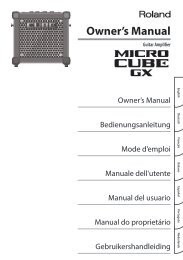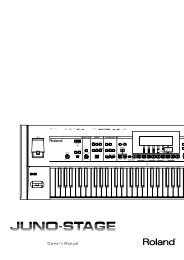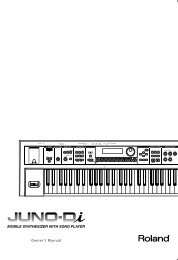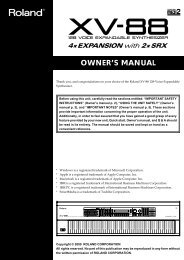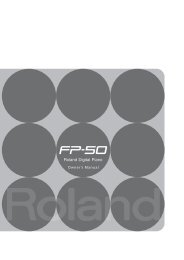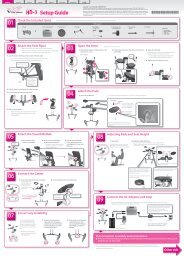Owner's Manual - Roland
Owner's Manual - Roland
Owner's Manual - Roland
Create successful ePaper yourself
Turn your PDF publications into a flip-book with our unique Google optimized e-Paper software.
Pan Depth (LFO1/LFO2 Pan Depth) ★<br />
Specifies how deeply the LFO will affect the pan.<br />
Value: -63– +63<br />
Positive (+) and negative (-) settings for the Depth<br />
parameter result in differing kinds of change in pitch<br />
and volume. For example, if you set the Depth<br />
parameter to a positive (+) value for one tone, and set<br />
another tone to the same numerical value, but make it<br />
negative (-), the modulation phase for the two tones will<br />
be the reverse of each other. This allows you to shift<br />
back and forth between two different tones, or combine<br />
it with the Pan setting to cyclically change the location<br />
of the sound image.<br />
When the Structure parameter is set to any value from<br />
“2” through “10,” the output of tones 1 and 2 will be<br />
combined into tone 2, and the output of tones 3 and 4<br />
will be combined into tone 4. This applies to the Pan<br />
Depth parameter settings. For this reason, tone 1 will<br />
follow the settings of tone 2, and tone 3 will follow the<br />
settings of tone 4 (p. 101).<br />
Patch Step LFO<br />
Step Type (LFO Step Type)<br />
When generating an LFO waveform from the data specified<br />
in LFO Step1–16, specify whether the level will change<br />
abruptly at each step or will be connected linearly.<br />
Value: TYPE1 (stair-step change), TYPE2 (linear change)<br />
Step 1–16 (LFO Step 1–16)<br />
Specifies the data for the Step LFO. If the LFO Pitch Depth is<br />
+63, each +1 unit of the step data corresponds to a pitch of<br />
+50 cents.<br />
Value: -36– +36<br />
How to Apply the LFO<br />
Creating a Patch<br />
● Apply the LFO gradually after the key is<br />
pressed<br />
fig.06-043.e<br />
Fade Mode: ON-IN<br />
Delay Time: The time from when the keyboard is played<br />
until the LFO begins to be applied.<br />
Fade Time: The time over which the LFO amplitude will<br />
reach the maximum after the Delay Time has<br />
elapsed.<br />
● Apply the LFO immediately when the key is<br />
pressed, and then gradually begin to<br />
decrease the effect<br />
fig.06-044.e<br />
high (more)<br />
Pitch<br />
Cutoff Frequency<br />
Level<br />
Pan<br />
low (less)<br />
high (more)<br />
Pitch<br />
Cutoff Frequency<br />
Level<br />
Pan<br />
low (less)<br />
Note on<br />
Fade Mode: ON-OUT<br />
Delay<br />
Time Fade Time<br />
Note on<br />
Delay Time Fade Time<br />
Depth<br />
Depth<br />
Delay Time: The time that the LFO will continue after the<br />
keyboard is played.<br />
Fade Time: The time over which the LFO amplitude will<br />
reach the minimum after the Delay Time has<br />
elapsed.<br />
119<br />
Overview Connections VS-700C Console VS-700R I/O Fantom VS Appendix



